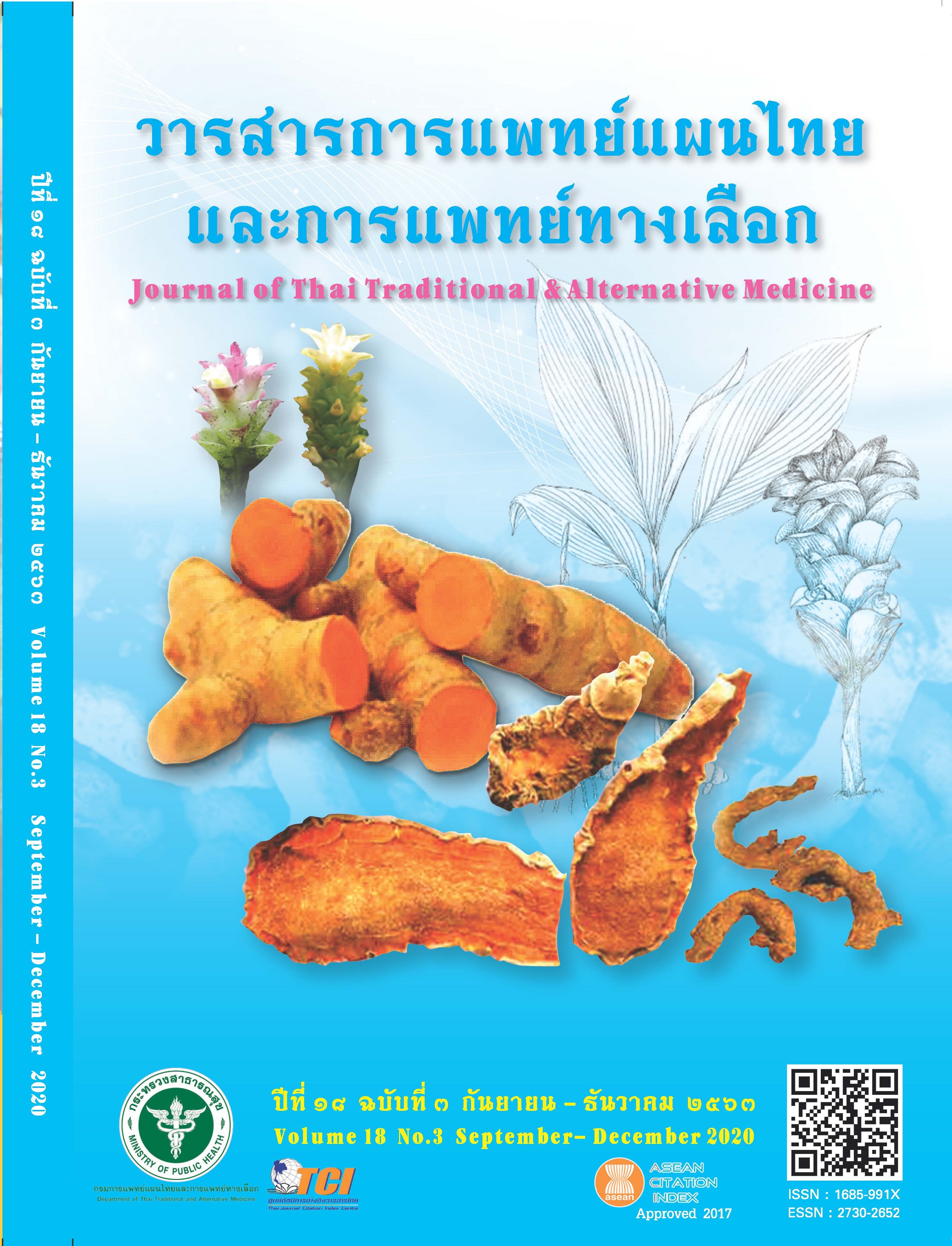A comparison between Mathurameha and Metformin in the result of efficacy and safety among new-onset type 2 diabetes
Main Article Content
Abstract
This study was done to compare the efficacy and safety of Thai herbal medicine of Mathurameha and Metformine among new cases type 2 diabetes patients at Watthana Nakhon Hospital, Sa Kaeo province. The clinical research trial was conducted by prospective study and purposive sampling method. We divided new onset of diabetic type 2 cases into 2 groups. The control group was treated with Metformin (500 mg) taking 1 tablet in the morning and evening after meals (73 cases), and the experimental group was treated with Thai herbal medicine Mathurameha (300 mg), taking 2 capsules each morning and evening before meals (80 cases), for 6 months. Repeated measures ANOVA were conducted for analyze HbA1C and fasting blood sugar. Blood sampling were collected for BUN, Creatinine, Cholesterol, HDL, LDL, Triglyceride and Urine before and after the research study. Adverse event occurred throughout of the study were followed. The result found that percentage change of mean and standard deviation of fasting blood sugar (FBS) and HbA1C among new-onset diabetic patients after treatment with Mathurameha and Metformin were -1.24 ± 15.70, 8.54 ± 23.18 (FBS) and -4.67 ± 30.31, -3.90 ± 31.70 (HbA1C), respectively. No serious adverse reactions were found in both subject groups. in conclusion Mathurameha herbal medicine effective in reducing blood sugar levels. But compared to Metformin was found to be less effective. However, we found the advantages of Mathurameha were suitable for use in type 2 diabetes patients who FBS less than 220 mg/dl, relatively obese patients (BMI > 30) and age under 60 years old.
Article Details
References
Thomas A, Rajesh EK, Kumar DS. The significance of Tinospora crispa in treatment of Diabetes Mellitus.
Phytother Res. 2016;30(3):357-66.
Srivanichakorn S. Morbidity and mortality situation of non-communicable disease (diabetic type 2 and cardiovascular disease) in Thailand during 2010-2014. Disease Control Journal. 2017;43(4):379-90. (in Thai)
Chetthakul T, Deerochanawong C, Suwanwalaikorn S, Kosachunhanun N, Ngarmukos C, Rawdaree P, Krittiyawong S, Leelawatana R, Bunnag P, Plengvidhya N, Pratipanawatr T, Benjasuratwong Y, Mongkolsomlit
S. Thailand Diabetes Registry Project: Prevalence of diabetic retinopathy and associated factors in type 2
diabetes mellitus. J Med Assoc Thai. 2006;89(1):S27-36
Diabetes Association of Thailand under The Patronage of HRH Princess Maha Chakri Sirindhorn. Clinical Practice Guidelines for Diabetes 2017. Bangkok: Romyen Media Company Limited; 2017.
Clinical Guidelines Task Force. Lifestyle management. In: Global guideline for type 2 diabetes. International
Diabetes Federation, Issue 1. Brussels, Belgium: IDF Communications; 2012. p. 32-7.
Evert AB, Boucher JL, Cypress M, Dunbar SA, Franz MJ, Mayer-Davis EJ, Neumiller JJ, Nwankwo R, Verdi
CL, Urbanski P, Yancy WS. Nutrition therapy recommendations for the management of adults with diabetes.
Diabetes Care. 2014;37(Suppl 1):S120-43.
American Diabetes Association. Standards of medical care in diabetes 2017. Diabetes Care 2017;40(Suppl 1):
S33-S43.
American Diabetes Association. Standards of medical care in diabetes-2017. Diabetes Care 2017. The Journal
of clinical and applied research and education. 40(Suppl 1):S25-S32.
Bunnag Pongamon. Rationale use of oral Hypoglycemic agents in type 2 diabetes [Internet]. 2017; Bangkok:
Mahidol University Faculty of Medicine Ramathibodi Hospital; Available from : https://med.mahidol.ac.th/
med/sites/default/files/public/pdf/medicinebook1/Oral%20hypoglycemic%20drugs.pdf
Clinical Guidelines Task Force. Global guideline for type 2 diabetes. International Diabetes Federation; 2012.
Sinclair A, Dunning T, Coagiuri S. IDF global guideline for managing older people with type 2 diabetes 2013.
International Diabetes Federation; 2013. 12. Morley JE, Sinclair A. Individualizing treatment for older
people with diabetes. Lancet. 2013;382:378-80.
Krisanapun C, Peungvicha P, Temsiririrkkul R, Wongkrajang Y. Aqueous extract of Abutilon nidicum Sweet
inhibits glucose absorption and stimulates insulin secretion in rodent. Nut Res. 2009;29(8):579-87.
Krisanapun C, Lee SH, Peungvicha P, Temsiririrkkul R, Baek SJ. Antidiabetic activities of Abutilon indicum (L.)
sweet are mediated by enhancement of adipocyte differentiation and activation of the GLUT1 promoter. Evid
Based Complement Alternat Med. 2011;2011:167684. doi:10.1093/ecam/neq004. PubMed PMID: 21603234.
Noor H, Hammonds P, Sutton R, Ashcroft SJ. The hypoglycaemia and insulinotropic activity of Tinospora
crispa: studies with human and rat islets and HIT-T15 B cells. Diabetologia. 1989;32(6):354-9.
Sriplang K, Adisakwattana S, Rungsipipat A, YibchokAnun S. Effects of Orthosiphon stamineus aqueous
extract on plasma glucose concentration and lipid profile in normal and streptozotocin-induced diabetic rats. J
Ethnopharmacol. 2007;109(3):510-4.
Murali YK, Chandra R, Murthy PS. Antihyperglycemic effect of water extract of dry fruits of Terminalia chebula in experimental diabetes mellitus. Indian J Clinical Biochem. 2004;19(2):202-4.
CM Chan, YW Chan, CH Lau, Tze Kin Lau, Kit-Man Lau, FC Lam, Chun-Tao Che, Leung Ping Chung, KP
Fung, Clara Bik San Lau, Yuan Yuan Ho. Influence of an anti-diabetic foot ulcer formula and its component
herbs on tissue and systemic glucose homeostasis. J Ethnopharmacol. 2007;109(1):10-20.
Kakuda T, Sakane I, Takihara T, Ozaki Y, Takeuchi H, Kuroyanagi M. Hypoglycemic effect of extracts from
Lagerstroemia speciosa L. leaves in genetically diabetic KK-AY mice. Biosci Biotechnol Biochem. 1996;60(2):204-
Wenli Hou, Yanfang Li, Qiang Zhang, Xin Wei, Aihua Peng, Lijuan Chen, Yuquan Wei. Triterpene acids
isolated from Lagerstroemia speciosa leaves as alphaglucosidase inhibitors. Phytother Res 2009;23(5):614-618.
Permphol P. Efficacy and safety of Mathurameha (Nirund Pongsoiphet and Foundation for the promotion of Thai Traditional Medicine Formula) for type 2 diabetes mellitus treatment. Bangkok: Thammasat University; 2015.
Safety monitoring on the use of herbal medicines by public hospital patients for the addition into the National List of Essential Medicines. Department of Thai Traditional and Alternative Medicine, Ministry of Public
Health; 2019.
Holman RR, Paul SK, Bethel MA, Matthews D, Neil AW. 10-Year Follow-up of Intensive Glucose Control in Type
Diabetes. N Engl J Med. 2008;359:1577-89

